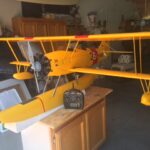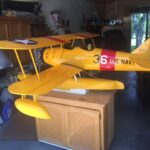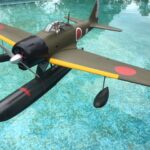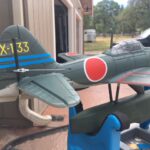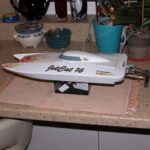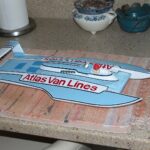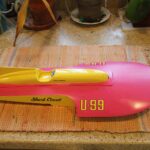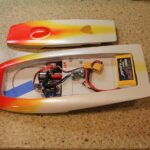Bill’s Projects for 2024
The following pics and excerpts were taken from a series of text messages throughout the year with Bill Allen.
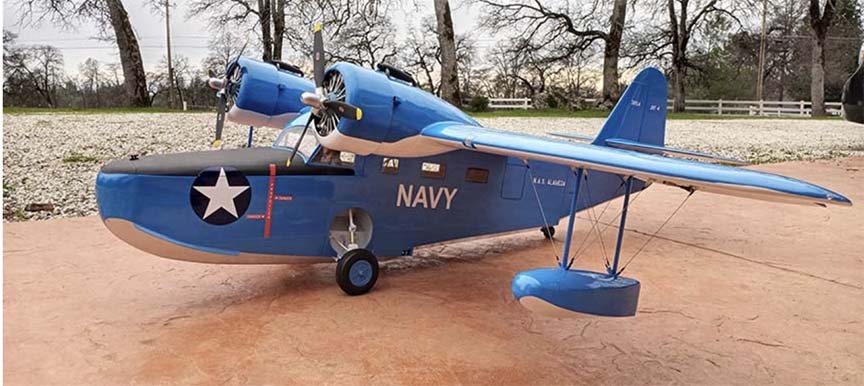
Blue Grumman Goose
Taxi test completed. Ready for sea/Lake trials. Two 3s 3200 packs but had to add another 10 oz of lead to the nose. Maybe eventually buy some 4000 packs. 11 pounds AUW. I built some spring shocks from brass and aluminum tubes. Also found Uxcell 4 inch tires much softer and lighter than Dubro. Yup, scale retracts.
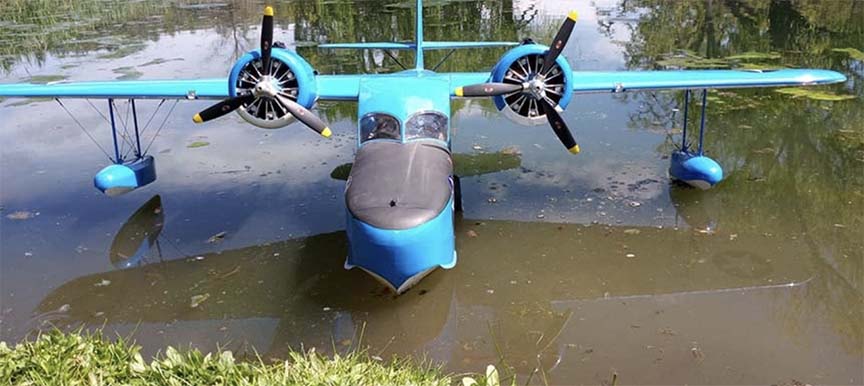
Teal Goose #2
Slight leak in the tail wheel. Just waiting for a cool calm day to fly the Goose.

N3N
I joined the Oroville club and went to their fly in last weekend. Nice field and great water flying access. I flew the big N3N and it was a hit. I took only one charged 2×5000 4s pack and got three 5 minute flights. Will maiden the Goose soon.

Dyke Delta
Dyke Delta from dollar tree sign board ready for maiden. 24oz. 1409 outrunner 2S 1100 cell. Fixed gear
Pretty silly looking but the full scale is very innovative and had good performance numbers. I met John Dyke years ago when he first revealed his delta. Interesting guy.
The Dyke Delta flies great. Just needed a couple clicks of up elevon. Plenty of power but too much authority with the full span elevons. Also some twist flex in the elevons. Now that I have the reflex set I will cut a couple inches off the elevon tips and make the ends permanent to the wing tips like the full scale.
Bill Allen’s Projects
I have not flown either plane the Sierra Flyers are flying now but their pond is too small for these planes. I will need to take them up to Orville as I joined their club (1.5 hour drive). But I need to find out what their status is. I was invited to fly as a guest at the Red Barons Club on Saturday but no water there. A very nice facility next to Beale AFB, but one hour away. I will send more pics of the N3N/Stearman (Hollywood N3N) haha when its done. I need to set the “N” struts and wing wires. Bill
Now I’m ready to fly in the club “pond”. 32” FMS Zero converted to “Rufe”
Click the pics above to enlarge.
Bill Knoll’s Boats Pt.1
Jet’s Dock
Click the pics to enlarge.
Hello, my name is Bill Knoll and one of the many nicknames I’ve earned over the years was given to me by none other than your very own Steve Belknap. This happened sometime back in the mid 1990s when I was experimenting with electric ducted fan jets. One fine day I was at the SEFSD flying field and was buying some desperately needed widget out the back of Steve’s 1968 Chevy van when he casually strolled up to me and asked something to the effect of “Who the hell do you think you are; some kind of Doctor Jet?” I looked at him in stunned amazement and thought……. That’s a cool name…..
Well, I adopted the name and the rest is history throughout the RC community.
I was heavily involved with the Silent Electric Flyers of San Diego, serving as Senior Flight Instructor, Vice President, and finally President of the club. That’s where I met Bob Mosley and Steve Belknap. Somewhere in the early-mid 2000s, I quit flying RC because it became more work and less fun. I still had the RC bug, so I built a few slope gliders to fly at the nearby cliffs.
Somewhere in the mid 1990s, I lived on a lake. Since it was only fifty feet from my back door to the water’s edge, I built some of Graupner’s RC speedboats to run. This opened up a whole new realm of RC to me. The challenge quickly became: How fast can I make it go? How reliable can I make it? I always maintained my fascination with FE (Fast Electric) racing since then.
Living in San Diego County and not really having a decent freshwater place to run the REALLY BIG and REALLY FAST boats, I built many of what was then considered as “micro” hulls. These were hulls of between 12“ at a minimum to about 20” at the biggest. In today’s world they are considered as “minis” since “micro” now means a whole new level of tiny, but I digress.
My big passion has always been in flying, and during the summer months, I still fly my 1961 Schweizer 1-26 Serial Number 144 as often and as far as I can. I have long since given up the sleek, sexy, high-performance fiberglass / carbon fiber speed-demons in favor of funky, old, tube-and-fabric ships.
When I was at the lake the other day, Bob saw some of the little boats I had designed and built. Bob commented that a number of the members had suggested racing some type of boat that was small, inexpensive, and less intimidating than your typical 12S powered 1/8 scale hydroplane or a 100 mph plus offshore cat. Bob also suggested I write something for the newsletter discussing the options for would-be racers and see who might be interested.
“Hmmm….” I thought. That sounds somewhat reminiscent of Speed 400 pylon racing back in the 80~90s. You would take a cheap Speed 400 motor, build the smallest, lightest airframe around it you could, and then race them…….. They were stupid fast! That was the birth of “Fast, Cheap, and Out of Control”.
Depending on the reception received, this will be the first in a series of articles to appear here and will be all about little electric boats that are “Fast, Cheap, and Out of Control”.
As it so happens, many of the hulls I brought to the lake today were prototypes of designs created with exactly that purpose in mind. For those who aren’t a big fan of time-consuming plywood and balsa builds, I have developed a small single-step hydroplane that uses essentially off-the-shelf hardware and is constructed of a sheet of insulation foam and some 1/32” styrene sheet. With a low Kv 2030 inrunner motor on 1000mah 2S, this little thing is on the edge of being grossly over-powered and requires pilot skill to keep it upright. It’s a challenge to drive. AND it was under $100 to put it on the water, including the receiver and motor battery. The big drawback is it doesn’t like rough water.
Another project I have been working on and this one is quite dear to my heart is 1:20 scale unlimited hydroplanes. This class was created for people that like to build balsa and plywood scale models with the object of having models built to resemble actual unlimited hydroplanes that raced on the circuit. For racing purposes, I’d further break them down into “shovelnose” and “pickle-fork” categories due to the different aerodynamics inherent in each style hull. Again, this style hull likes smoother water, but is a bit more forgiving of some small chop as compared to the foamie single-step hydro. Hydroplanes by definition require a lot of “dialing in” to get the maximum out of them.
The next project I’d like to discuss would fit into what the “BIG” guys consider the “Offshore” class. By definition, the offshore class must compete in some really churned-up water. V-hulls and catamarans will excel here. There are far more commercially available options here, from toy-grade injection-molded styrene boats to competition-grade carbon-fiber hulls with flux-capacitance drive and rainbow unicorn squeezins’…… There are more than enough decent toy hulls, composite hulls, and wood kit hulls out there to satisfy almost anyone. I have developed a 16” twin-motor balsa and plywood catamaran for this category of racing.
Lastly, I am currently designing a plywood and balsa 12” single-step V-hull that will use the same low Kv 2030 inrunner I used in the single-step hydroplanes. This design would also fit into an :Offshore” class. This design is based on an existing composite hull available from a German manufacturer and should be able to handle almost any water condition Lake Poway can dish out. It will have a flood chamber to make it self-righting. That’s the perfect thing for racing! This project is currently WAY DOWN on the building queue though and may be many months before the design is ready for a prototype build.
All the designs I have developed are balsa and plywood builds. I realize that there may be people that do not want to build and would rather have something “Off the Shelf”. I will also address what is commercially available at all levels, but I will stay limited to the minis. A commercially-available 36” twin-motor catamaran capable of 75 mph out of the box may be cool, but it would also eat up a lot of real estate on the lake and completely interfere with all aircraft operations. Bad idea! The minis can easily operate on the east side of the pier and stay completely out of the way of aircraft operations. Better idea!
I welcome your questions and comments, and hope there will be some interest in racing one or more categories of mini hulls.
Stay tuned…..
Doc


